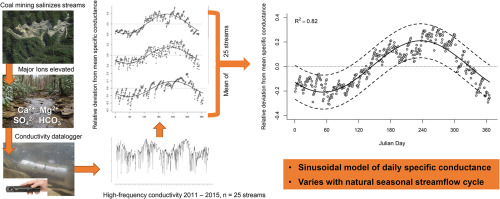Water Research ( IF 12.8 ) Pub Date : 2018-01-08 , DOI: 10.1016/j.watres.2018.01.012 Anthony J. Timpano , Carl E. Zipper , David J. Soucek , Stephen H. Schoenholtz

|
Salinization of freshwaters by human activities is of growing concern globally. Consequences of salt pollution include adverse effects to aquatic biodiversity, ecosystem function, human health, and ecosystem services. In headwater streams of the temperate forests of eastern USA, elevated specific conductance (SC), a surrogate measurement for the major dissolved ions composing salinity, has been linked to decreased diversity of aquatic insects. However, such linkages have typically been based on limited numbers of SC measurements that do not quantify intra-annual variation. Effective management of salinization requires tools to accurately monitor and predict salinity while accounting for temporal variability. Toward that end, high-frequency SC data were collected within the central Appalachian coalfield over 4 years at 25 forested headwater streams spanning a gradient of salinity. A sinusoidal periodic function was used to model the annual cycle of SC, averaged across years and streams. The resultant model revealed that, on average, salinity deviated approximately ±20% from annual mean levels across all years and streams, with minimum SC occurring in late winter and peak SC occurring in late summer. The pattern was evident in headwater streams influenced by surface coal mining, unmined headwater reference streams with low salinity, and larger salinized rivers draining the study area. The pattern was strongly responsive to varying seasonal dilution as driven by catchment evapotranspiration, an effect that was amplified slightly in unmined catchments with greater relative forest cover. Evaluation of alternative sampling intervals indicated that discrete sampling can approximate the model performance afforded by high-frequency data but model error increases rapidly as discrete sampling intervals exceed 30 days. This study demonstrates that intra-annual variation of salinity in temperate forested headwater streams of Appalachia USA follows a natural seasonal pattern, driven by interactive influences on water quantity and quality of climate, geology, and terrestrial vegetation. Because climatic and vegetation dynamics vary annually in a seasonal, cyclic manner, a periodic function can be used to fit a sinusoidal model to the salinity pattern. The model framework used here is broadly applicable in systems with streamflow-dependent chronic salinity stress.
中文翻译:

温带森林水源流中人为盐渍化的季节性模式
人类活动导致的淡水盐渍化在全球范围内日益引起关注。盐污染的后果包括对水生生物多样性,生态系统功能,人类健康和生态系统服务的不利影响。在美国东部温带森林的源头水流中,比电导(SC)升高(一种用于测量盐度的主要溶解离子的替代物)已与减少水生昆虫的多样性有关。但是,此类链接通常基于有限数量的SC测量,这些测量无法量化年内变化。有效管理盐碱化需要工具来准确地监控和预测盐度,同时考虑到时间的变化。为此,历时4年,在阿巴拉契亚中部煤田内,在25个覆盖盐度梯度的森林源头水流中收集了高频SC数据。使用正弦周期函数来建模SC的年度周期,将其跨年和按流平均。所得模型显示,平均而言,所有年份和溪流的盐度平均偏离年均水平的±20%,最低的SC发生在冬季末,而峰值的SC发生在夏末。这种模式在受地表煤矿开采影响的源头水流,盐度低的未开采源头参考水流以及研究区域的较大盐化河流中很明显。该模式对流域蒸散量驱动的季节性稀释变化有强烈的响应,在未开采的流域,森林覆盖率相对较高的情况下,这种影响略有放大。对替代采样间隔的评估表明,离散采样可以近似于高频数据提供的模型性能,但是随着离散采样间隔超过30天,模型误差会迅速增加。这项研究表明,美国阿巴拉契亚州温带森林水源流中盐度的年内变化遵循自然的季节性模式,这是对水量和气候,地质及陆生植被质量的相互作用的影响所致。由于气候和植被动态每年以季节性,周期性的方式变化,因此可以使用周期函数将正弦模型拟合到盐度模式。



























 京公网安备 11010802027423号
京公网安备 11010802027423号